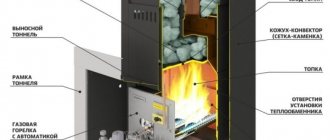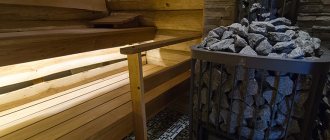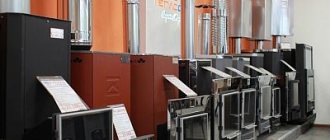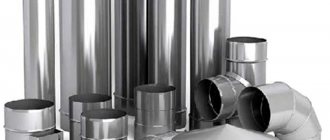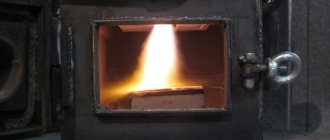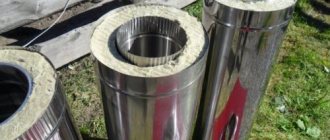The key to the pleasure you get in a bathhouse is always thoroughly warming it up to the desired temperature. Otherwise, the procedure itself loses all meaning, wouldn’t you agree? The entire load for this part falls on the oven, which must be properly prepared. You can, of course, save yourself the headache about this and turn to specialists. Or you can put in a minimum of effort, but as a reward you will receive a well-prepared oven and a significant amount of savings. How to make a sauna stove from a pipe with your own hands? In fact, using such material as a source allows you to reduce time costs to a minimum - and not at all to the detriment of the final result. The main thing is the availability of the necessary materials and a drawing, according to which you can successfully implement the plan and avoid mistakes that undermine safety.
Vertical or horizontal format?
One of the key issues that you will have to decide if you intend to make a sauna stove from a pipe. Of course, it directly depends on the size of the steam room.
Vertical - ideal for small spaces. The grate bars and the direct firebox are placed in steps, one above the other, which ultimately allows you to save useful space around. The use of this format has recently become noticeably more frequent, especially among professionals. It is better to avoid disputes about which stove is best suited for a bath: make a decision based on your specific situation.
Horizontal is a solution that fits well into the format of spacious bath rooms. At the same time, this is the classic version that is used almost everywhere. Characterized by a slightly enlarged firebox compartment. Often, for practicality, part of it goes into the dressing room, which allows you to speed up the sometimes rather tedious process of kindling.
Agree that it is much more convenient to regulate the temperature from it without wasting time moving from one room to another. In addition, during such “raids” the air actively circulates throughout the bathhouse and prevents its full heating.
Decorative finishing
A stove in a bathhouse is not only a source of heat, steam, and increased danger, it can also be a decoration for the room.
If you only care about the safety of the stove, then it is enough to paint it with modern paint to protect the metal from corrosion. The use of heat-resistant enamel based on silicone paints is no different from conventional enamels, but protects metal at temperatures up to +800 degrees. The metal is degreased and then paint is applied. After the first layer has dried, the next layer is applied. It is recommended to paint those metal elements that will be covered with brick and insulation.
The decoration of the stove in the bathhouse can perform a purely decorative function in the form of forged decorations and additional decorative elements of the stove itself. You can use heat-resistant paints of various colors with an antique effect. Decoration can also be used to eliminate the increased danger of a sauna stove.
The stove can be lined with red brick masonry (we have already considered this method), but the masonry on the sides can be decorative, in the form of a grid. On the firebox side, the stove can be covered with a screen made of forged elements or simply with a beautiful mesh fixed in the frame.
It can be covered with a beautiful casing, also covered with heat-resistant paint, in the color you like.
A stove lined with heat-resistant stone will look impressive; this will not only give a noble look to your product, but will also improve the quality of the stove itself.
The decorative decoration of your bathhouse stove depends only on your desire, taste and wallet size.
Preparing the foundation
- in the place where you plan to place the stove, make a hole 0.5 meters deep, the length and width can be increased to 0.7 meters;
- approximately 0.3 meters high, fill the prepared hole with very fine crushed stone and carry out thorough compaction;
- prepare a cement composition based on cement-sand in a ratio of 1 to 4, dilute the mixture with water and pour it onto the crushed stone;
- within 24 hours the base will dry and become hard - place several sheets of roofing material on top for reliable protection from moisture;
- prepare a concrete composition of cement, sand, fine gravel and water in a ratio of 1:2:4 and pour it onto the roofing material;
- carefully level the base using a building level;
- after drying, make a brick platform approximately 0.7 meters in width and height;
- also arrange a protective brick screen up to 1.2 meters high - in the future the stove will be located in close proximity to it, approximately at a distance of 0.2 meters.
Gas sauna stove from a cylinder
To independently assemble a gas stove for a bath, you will need to collect and purchase the following materials:
- You need to buy an atmospheric burner at the construction market or in a store with gas equipment.
- Find an old but not rusty gas cylinder. A new cylinder, large-diameter pipe or sheet of metal with a thickness of 8 to 16 millimeters will also be suitable.
- For the base of the heater you will need thick metal, for example, a brake disc from a car. It will last for at least several years.
- A gas pipe with a diameter of 5 centimeters and a length of approximately 3 meters.
- A pipe with a diameter of 10 centimeters, which will be used to remove gases.
- Some copper or bronze elements to connect parts.
- Additionally, you will need to acquire the following tools: grinder, welding machine, drill, measuring instruments.
After assembling the complete set of tools, you need to use a grinder to cut off the outer part of the cylinder so that the cut diameter is equal to the external size of the brake disc. Then, using welding or a drill with bolts, you need to attach the disk to the cylinder.
The next step is preparing the air supply pipe. In a pipe with a diameter of 5 centimeters you need to drill about ten 5-mm holes.
A hole with a diameter of approximately 55 millimeters is also made at the bottom of the cylinder. The whole, that is, not drilled, part of the five-centimeter pipe should extend out of the cylinder by about two meters. It must be welded to the cylinder.
First you need to cut the workpieces with a grinder according to the sketch. Then weld all the components using a welding machine. After completing these procedures, you must also grind all welds. The same grinder copes well with this task
The pipe that will supply gas is welded in the same way. An adapter is attached to the second end of this pipe, with which you can connect the device to a gas pipe or gas cylinder.
A hole is cut out on the cylinder for the chimney and the corresponding pipe is welded. Using a grinder, a rectangular hole for the door is also cut. The hinges are welded and the door is hung directly on them. You also need to attach a handle to the door.
In this way, a simple model of a gas oven will be made. Gas is supplied to the burner through the pipe. The combustion process is started, depending on the burner, by piezo ignition or electric pulse.
Horizontal oven - step by step
- prepare a working piece of pipe 0.7-0.9 meters long;
- thoroughly clean all edges;
- cut a fragment measuring 0.8 by 0.4 meters from the prepared metal sheet;
- Weld rods horizontally to the opening in the middle, and a grate in the lower part of the pipe;
- make a remote-type firebox from a metal sheet and make cutouts;
- weld this facade to the base pipe;
- to decorate the back wall, cut out a circle equal to the diameter of the pipe and weld it to the main structure;
- You can make a hole for the chimney in the upper part - a small size, approximately 0.16x0.16 meters, will be enough;
- weld the main vault and the pipe that will be used as a chimney;
- all that remains is to install the doors for the combustion chamber and the blower;
- finishing comes down to careful sanding of the entire body, and then treating it with durable polymer-based paint.
Here are some drawings and pictures that will help you in making a horizontal type oven.
Important Tips
- To prevent heat from leaving the stove container, an opening valve is installed on the edge of the chimney.
- A fire can be caused by a huge accumulation of soot. To do this, two holes are drilled in the pipe. Steel tubes are inserted into them and turned towards the pipe. This prevents the appearance of soot. The fuel will burn completely, and soot accumulation will be minimal.
- After completing the construction, it must be checked for holes, gaps and cracks.
- There should be no objects around the stove that are susceptible to fire: synthetics, wood and fabric.
- All cut edges of pipes and metal sheets must be cleaned of sharp edges to avoid cuts. If you do not have experience in correctly installing a chimney, then it is better to contact specialists.
- The installation of this furnace should be done on a finished concrete foundation, its height is 250-300 mm. Brickwork with clay mortar is laid on it in one or two rows. A brick screen will protect the walls from overheating.
Drawings and photos of a horizontal stove made of pipe 530
Very often, a 530 diameter pipe is used to make a sauna stove. It allows for longer combustion of wood, significantly increases the performance of the stove, and is generally more convenient to work with. Therefore, photos and drawings of a stove for a bathhouse made of pipe 530 in horizontal format will be useful to you if you decide to build this type of building. Below we offer you popular options that have been tested in practice.
Advantages and disadvantages of the "potbelly stove"
No matter how strange it may sound, a potbelly stove for a garage is a very important accessory. For opponents of her presence in that room, the following arguments can be made in her favor:
- The oven takes up little space and is quite compact;
- It does not require much maintenance - its simplicity of design and unpretentiousness make it the best option;
- The simplest fuel is used for it - firewood, briquettes, coal;
- If desired, it can be upgraded - install additional screens or switch to liquid fuel (used engine oil or diesel fuel);
- You can assemble it with your own hands; for this you will need the ability to work with a grinder and electric welding, 500 rubles to buy parts and 5-8 hours of free time.
True, there are also disadvantages:
- Although this is a stove with an ash pit, a ash pit and a closed firebox, it cannot be left unattended;
- It cools quickly and does not retain heat at all;
- Although it is compact, the car must be parked at a certain distance from it, and there is usually not enough space in a standard garage box.
But, despite all these inconveniences, baking in the garage is a great thing. You can work in cold weather, or you can sit with your friends. And also to protect yourself from the righteous anger of your wives and sit out in the warmth until they cool down and change their anger to mercy.
Vertical oven - step by step
- prepare the base - a pipe fragment up to approximately 0.9 meters;
- Weld a circle of metal sheet to the bottom of the pipe - it should be equal to the diameter of the pipe;
- cut a hole for the ash pan, its maximum width is no more than 0.2 meters;
- weld a round plate with a pipe diameter, cut out the middle and weld rods onto the hole - this will be the grate;
- decorate the combustion chamber by cutting out a small rectangle above the grate and seal it with a metal door;
- Again, cut a hole above the firebox, weld rods for the grate and hang the door;
- weld the body with a round piece of metal, do not forget about the holes for the chimney and ash pan;
- The traditional finale is sequential sanding of the entire body and painting.
To help you, there are drawings and photos that will help you make your own stove for a bathhouse from a pipe in full compliance with all safety standards. By the way, don’t forget to do the first warm-up in the fresh air - this way you will avoid fumes from the paint you used getting into your respiratory tract. After all, many polymer compounds are frankly harmful to your health. Remember that an iron stove made of pipe is best lined with brick. This way it will be better to retain heat in the steam room, and the air will be protected from those substances that are released into it when the iron warms up.
Chimney installation
The chimney is an important component for removing combustion products.
They come in three types:
- Ceramic. A ceramic chimney has the longest shelf life. Maximum resistance to high temperatures.
- Brick. Due to its rough surface, a brick chimney quickly accumulates soot and slows down air draft.
- Steel. A steel chimney is most suitable for a bathhouse due to its affordable price. Also, due to the rapid heating of the metal, a tank is installed and then used for procedures. A stainless steel chimney is the most current. This material is not afraid of water, high temperatures, is not susceptible to corrosion, is lightweight, durable and cheap.
Build process:
- Before installation, you need to mark the location for making the hole.
- A galvanized steel casing is installed on the pipe, after which rings are put on and fixed to the ceiling. The lower pipe is secured with self-tapping screws. The clamps securely fix the chimney.
- The second part is installed on the roof. The holes between the roof and the chimney are filled with expanded clay, clay or asbestos.
Drawings and photos of a vertical stove made of pipe 530
As with the horizontal format, the 530-diameter labor is ideal for use if you are making the oven yourself rather than enlisting the help of a professional. A stove for a bathhouse made from pipe 530 vertically will help you make drawings with all the necessary markings. Needless to say, this makes your work much easier, because the most difficult thing is to make the necessary markings. Of course, the proposed options are not an axiom. You are also free to make necessary changes to them. With one condition - if you really know what you are doing!
Possible errors during the manufacturing process
If the finished design does not work as desired, most likely an error was made during the manufacturing and installation of the stove.
If there is a rapid removal of heat from the stove, a movable valve must be installed inside the chimney pipe.
A large accumulation of soot inside a horizontal oven can cause it to catch fire. An afterburner in the form of two metal tubes bent towards the pipe and installed on one of the walls of the structure will help solve the problem. As a result, the amount of soot will be reduced, and the firebox will be better saturated with oxygen, resulting in complete combustion of the wood.
Do-it-yourself potbelly stove - varieties
Do-it-yourself potbelly stoves can be divided into 3 types:
- Well-thought-out designs that embody useful heating ideas.
- Functional products, but not fully developed.
- Homemade devices created from scrap materials of low quality.
Quality products
Model PETIT GODIN
These types of hand-made potbelly stoves include:
- Brick stove for a bath. Brick was not initially used as a material for this type of stove. However, with a reasonable approach, it is possible to make a design with an efficiency of 40%.
- Potbelly stove being worked on. This is an effective and quite economical version of the stove, which is suitable for heating a garage or other utility room. The filling hole should be located in the far corner of the tank. To add used oil, a funnel with a curved spout is constructed. In this case, fire safety rules must be observed.
Middle class working stoves
Among the most common potbelly stoves in this category are:
- Barrel construction. This is the most practical option, which is made from a regular 200-liter barrel with a diameter of 600 mm. A hexagon with a side of 314 mm must be mounted into such a circle. The efficiency of such a potbelly stove is no more than 15%.
- A stove from a cylinder. For this option, a household gas cylinder, which is laid on its side, is suitable. The chimney is located in the far part of the firebox.
The barrel is taken as a basis
In both the first and second models of potbelly stoves, the roof of the stove is curved, spherical or cylindrical. The easiest homemade potbelly stove to implement is a gas stove. A propane burner is inserted into the firebox, and the structure is ready. Furnaces using such fuel must have a developed heat exchange surface, since gas is an energy fuel, and combustion products easily and quickly evaporate through the pipe.
Principle of operation
From a barrel
In the smoldering zone of firewood, there is an outflow of flue gases, which contain a certain amount of thermal energy. In order to take away this energy, it is necessary to create conditions under which the possibility of fire arises. Therefore, in the additional combustion chamber, which is located above the smoldering zone, and where the flue gases enter, oxygen is supplied in a small amount. The two gases are mixed and an air-gas mixture is formed, which burns well. A purely pyrolysis process is activated.
In order for the technology described above to be carried out with maximum efficiency, it is necessary to ensure that the convection currents that emanate from the smoldering zone of the fuel are slightly greater than the throughput of the chimney pipe.
What errors can reduce the efficiency of the device:
- Large stack of firewood. In this case, there will only be enough oxygen to support the smoldering process of the firewood. It will no longer be sufficient for combustion of flue gases.
- Small bookmark. But here it’s the other way around. The air coming from the ash pan will be distributed throughout the entire volume of the firebox, which is not completely filled. Part of it will evaporate, while in the second combustion chamber the combustion of gases will occur ineffectively due to excess oxygen.
Compact design
Both options are ineffective only because the pyrolysis process is not included. It turns out that it is impossible to manufacture long-burning wood-burning stoves to the maximum possible dimensions. There are certain restrictions depending on the amount of firewood installed that will support the pyrolysis process. This is an important point. That is why potbelly stoves of this type have a power in the range of 8-20 kW, with an efficiency of 75%.
Types of structures
They differ in structure and operating principles. Let's look at each type in more detail.
Open
The stones are laid on top of the stove structure and are not covered with anything. Due to this, the steam room warms up faster, reaching temperatures of up to 100 degrees. But the humidity in the room is low, so the heat turns out dry.
The product consists of three parts:
- fireboxes;
- compartments for stones;
- containers with water.
There should be few stones, otherwise the top layer will not warm up well and the steam room will not be warm enough.
To increase the level of humidity and the release of water vapor, the hot stones are simply watered. One or two ladles will be enough - this will give up to 15% humidity.
To increase the level of fire safety and reduce the risk of burns, it is recommended to lay fire-resistant bricks around the walls of the furnace or make a partition made of wood.
To heat a sauna, it is important that as much of the stove area as possible is in contact with the air space. This contributes to faster heating of the air in the steam room
Closed (lined with brick or stone)
If wood fuel is chosen for heating, you will have to prepare large reserves in advance. Such a stove takes a long time to reach the desired temperature, but, having reached the desired level, gives good heat transfer and retains heat for a long time.
Closed structures are great for large baths, where there is not only a steam room, a wash room, a dressing room, but also a relaxation room.
One of the advantages is closed stones. Therefore, there is no risk of getting burned.
In factory economical models, the stove has a double casing with a gap for air exchange between the walls.
Combined
For most manufacturers, the design consists of a high box with gratings and double valves (performs the function of a firebox). A chimney pipe emerges from the neck of the box. Stones are placed in the neck here.
There are devices available for sale with combined fuel types:
- gas-wood;
- electric wood-burning.
They do not need to be constantly monitored. Simply adjust to the desired temperature.
By design they are divided into 3 types:
- Monoblock. With heat exchanger, combustion chamber. Gas burner of a fixed type, covered with a steel sheet.
- Paired. They have two separate combustion chambers for wood and gas.
- Reconfigurable. Universal device. Can be modified for each fuel.
The first two types do not need to be reconfigured, since you can switch from one type of fuel to another.
Gas is used as main gas or liquefied in cylinders.
The electric-wood-burning design allows you to successfully heat the bathhouse using electricity or wood (optional). Moreover, firewood is considered the main raw material. When they burn out and the temperature drops, the electric heater automatically starts working. There are two heating elements on the sides of the product. Such stoves operate on a 220 W network, with a three-phase voltage of 380 V.
The owners can choose which fuel to heat the bathhouse with. But such designs are many times more expensive than simple wood-burning stoves.
Making a potbelly stove during mining
Diesel fuel and used engine oil are very high-calorie fuels. If you get it inexpensively, then there is no point in messing with wood and coal; it’s easier to make a reliable stove - a dripper. Its principle of operation is to burn waste dripping into a hot bowl. Moreover, along the way, the liquid fuel has time to warm up, as it passes through an oil line built inside the afterburner pipe. The design of a drip-type potbelly stove is shown in detail in the drawing.
For efficient oil combustion, air is forced into the stove using a fan, and waste flows naturally from a tank suspended from the wall next to the heater. Another option is the forced supply of fuel by creating pressure in the fuel tank (for example, with a hand pump).
The stove body can be either a pipe Ø219 mm or a propane cylinder with a diameter of 30 cm. Making an oil stove with your own hands is not a difficult task, the main thing is to correctly make the holes and slots in the afterburner and lay the fuel line to the bowl installed on the bottom. A complete assembly guide is provided in our other article. You can get a closer look at the operation of the heater from the video:
Boiler installation rules
For the construction of a bathhouse, a flammable material is usually used - wood, so compliance with the following fire safety rules is the main requirement when installing a heating device:
- The boiler cannot be placed directly on a wooden floor; it needs a support made of non-combustible material - a brick base, a concrete slab or a thick sheet of metal.
- The room where the boiler is installed must have good ventilation to prevent combustion products from accumulating inside the room.
- To protect the boiler chimney from condensation, it is recommended to carry out thermal insulation measures using mineral insulation.
conclusions
The level of tilt of the body does not affect the operation of the stove. Therefore, you can install it arbitrarily. It is possible to treat the chimney with a high-temperature compound. This will help eliminate the metallic smell. After several fires, the pipe burns out and turns red. No further oxidation of the metal occurs.
As you can see, you can build a horizontal stove for a bathhouse yourself, if you get acquainted with the main stages of work and the features of preparation. It is important to choose the right materials and find all the necessary tools. If you have basic welding skills, you can make an effective structure that will last for decades.
Recommended Posts
DIY cellar
Wall mounted metal shelves
How to make a birdhouse with your own hands
How to make a swing nest with your own hands
How to make a cellar lid with your own hands
How to make a fountain in your country house
Basic safety rules
Solving the problem of how to weld a metal stove for a bathhouse is not difficult. The main thing is to comply with fire safety rules when carrying out all work:
- the finished stove can be installed indoors only after repeated preliminary heating in the open air;
- all seams must be welded tightly;
- only high-quality material can be used in compliance with all specified dimensions;
- the stove is positioned so that the firebox opening is opposite the front door;
- there should be no wooden floors, walls, etc. near the stove;
- around the stove, the floor and walls of the room must be covered with sheet steel and heat insulation;
- the chimney pipe is led outside, the minimum height is 70 cm above the roof ridge;
- around the passage of the smoke exhaust pipe through the roof you need to apply a layer of plaster, then whitewash it with lime;
- Small tubes should be installed in all technological openings in the direction of the chimney - this will prevent soot from accumulating;
- a damper must be installed in the smoke exhaust pipe to regulate draft;
- Chimney pipes must be cleaned periodically to avoid accidental combustion of accumulated soot.
The walls near the sauna stove must be insulated for fire safety
General information
The peculiarity of a sauna stove is that it performs several functions at once:
- Warms the air in the rooms;
- Heats water, which is needed for hygiene procedures;
- Warms up the stones.
It must be said that according to the principle of operation, do-it-yourself sauna stoves made from pipes and factory designs are no different. Of course, factory-made products may have more features and a more attractive design.
However, if the work is done carefully, a homemade stove will adequately cope with the tasks assigned to it, and will not disappoint its owners.
Factory stove-heater
Boiler structure
The boiler design must include the following components:
- The firebox is a thick-walled metal chamber where the fuel combustion process occurs. The bottom of the firebox is a grate through which the ash is poured into the ash pit.
- The ash pan is the space under the combustion chamber. It is used to collect and conveniently remove ash waste, as well as to draw air into the furnace necessary for fuel combustion.
- Kamenka is a special container filled with stones. Carries out redistribution and removal of heat.
- The water heating tank is located just above the firebox.
- A heat exchanger is a small container designed to transfer the energy of burning fuel to a coolant.
- Chimney is a channel necessary for removing smoke. It starts from the combustion chamber, then passes through the tank or heater, heating them and ends with a chimney. To adjust the draft it is equipped with a valve or gate.


